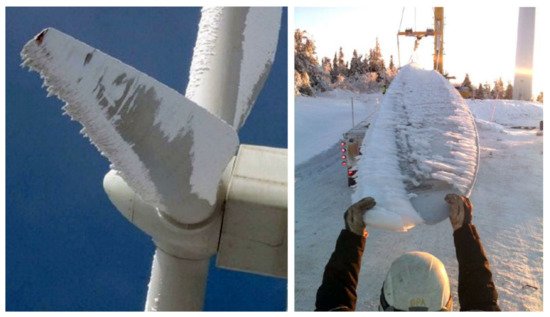The wind turbine is a complex structure. Although there is no single approach and there is variability in the commercial designs, a typical WTB is a thin-walled multi-cellular hollow airfoil shaped cross-section. For its manufacture, a number of materials and material systems are used for structural purposes (fibre composites and sandwich composite systems) as well as aesthetic purposes (primers, UV gel coats, paint, etc).
The potential causes of wind turbine blade failures can be classified into the following four categories:
1. damage from lightning;
2. failures due to fatigue;
3. leading edge erosion;
4. damage from icing.
The types of damage caused to wind turbine blades—originating from the above four different sources—along with their significance to the turbine’s performance and secure operation, are detailed in the following sub-sections.
- wind turbine blade damage
- lightning
- leading edge erosion
- icing effect
- de-icing
- anti-icing methods
- fatigue loads
1. Damage from Lightning
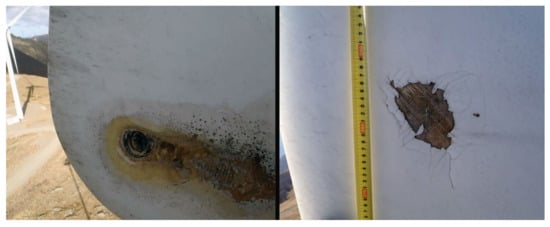
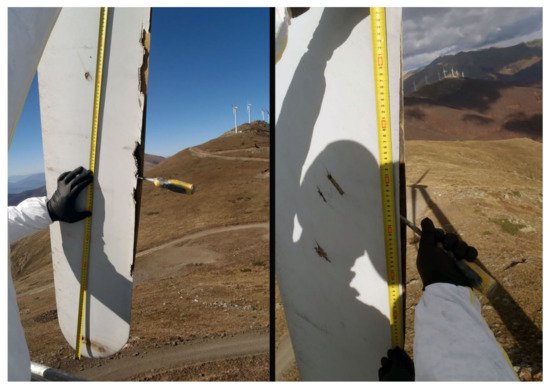
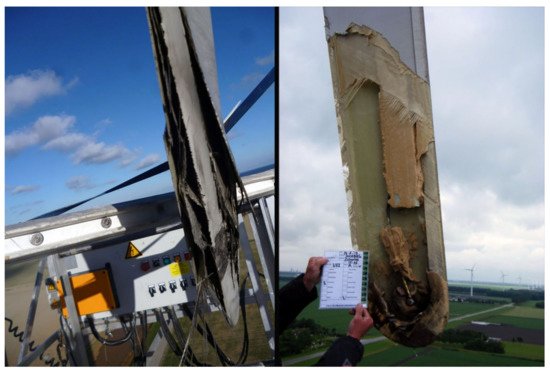
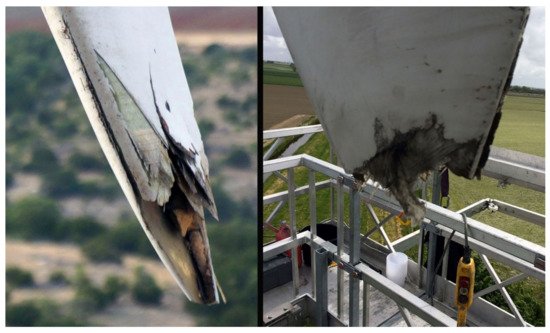
-
More than 60% of the total damage occurred within the last meter of the blade, and 90% of all damage was located within the last 4 m. The remaining 10% of damage was found mainly from 5 m to 10 m from the blade tip. There were only three lightning incidents further inboard, at 15 m, 20 m and 22 m from the tip.
-
The most common type of lightning damage was delamination (72.4% of total blade damage), followed by debonding of the shells (24.7%). Shell and tip detachment each occurred in 1.4% of the investigated cases.
-
Wind turbines suffering damage to more than one blade are uncommon (2.7% in two blades and 0.7% in three blades). A single lightning stroke sweeping from one blade to another due to the blade rotation, different branches of a single lightning strike attaching to the blades, or different lightning events during a thunderstorm can be the potential causes of damage observed in more than one blade of the same wind turbine [21]. In any case, it is shown that damage to more than one blades of a single wind turbine is a rare event.
2. Fatigue Damage on Wind Turbine Blades
The term “fatigue” is used to describe the inability of a material to persistently withstand cyclic applied loads, which are fully tolerable when applied only once or for a few repetitions. During its operational lifetime, a wind turbine faces repetitious loads that contribute to the fatigue of the overall structure. Wind is the main source of these loads, which can be steady loads, transient loads from events such as gusts, periodic loads from wind shear and stochastic loads from turbulence. Additional loads can be developed by the turbine’s cyclic starts and stops, yaw error, yaw motion, resonance-induced loads from vibration of the structure and loads from gravity as well. The main parameters affecting the potential occurrence and magnitude of fatigue loads and the resulting fatigue-induced damage in wind turbines are the surrounding environment and the land morphology of the installation area—more specifically, how the flow characteristics are affected by the land morphology and other obstructions. Regarding the surrounding environment of a wind park, surface wear can be caused on the blades’ outer coating by corrosive pits from sand or rain impingement or even seawater, in the case of offshore or near-shore wind park installations. These initially small wear points would act as stress concentrators during cyclic loading, causing the initiation of localized cracking. Moisture also can constitute another critical environmental parameter of fatigue damage caused mainly to the wind turbine blades. Despite the fact that glass fibre reinforced polyester (GFRP) blades are adequately water insulated, moisture can still penetrate into the blades’ inner material. Obviously the most fatigue-critical part of a wind turbine’s blade is the blade’s connection to the hub, because it has to bear all of the blade’s mechanical loads transferred and gathered at this particular point. For the connection of the blade with the turbine’s hub, a bolted joint is commonly used. The major effects of absorbed moisture on the laminates are as follows [24]:-
Reduction of the glass transition temperature of the matrix resin
| Material | Maximum Moisture Absorption (%) | Stiffness Change (%) | Fatigue Strength Reduction (Cycles) |
|---|
- Damage to the interface between the fibres and the resin
| Glass polyester | 4 | −10 |
- Reduction of the cure-induced residual stresses through swelling, which may retard failure
-
Particularly in wind park installations in locations with subzero temperatures, the presence of moisture turning to ice. Ice formation can act as a wedge between the plies and leads to delamination propagation.
| −35 × 10 | |||
| 3 | –−10 × 10 | 7 | |
| Glass epoxy | 2 | −10 | −20 × 103–−5 × 107 |
| Carbon polyester | 1.5 | 1 | ±0 |
| Carbon epoxy | 1.5 | 1 | |
| Glass—carbon epoxy | <2 | ±0 |
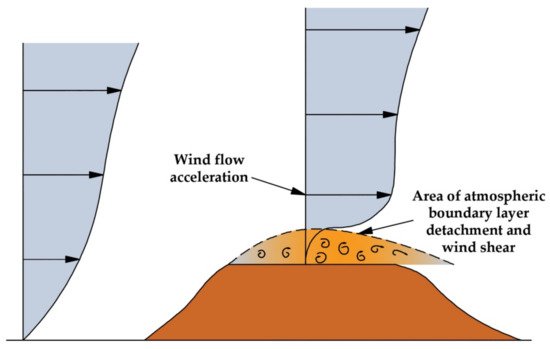
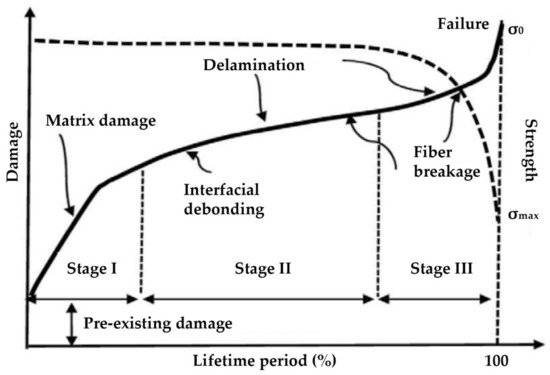
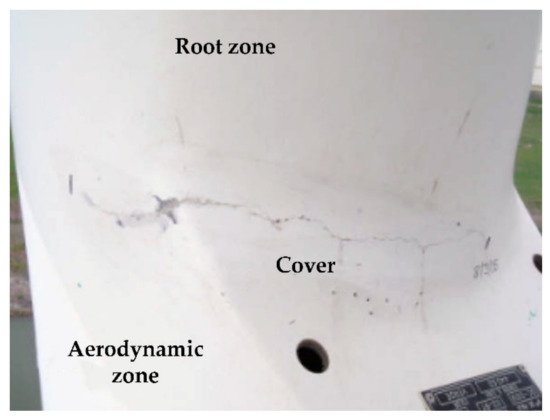
3. Leading Edge Erosion
In general, leading edge erosion of a wind turbine’s blade is the result of its exposure to:-
airborne particulates, mainly in the form of rain, hailstone, sea-spray, dust and sand
-
UV light and humidity/moisture.
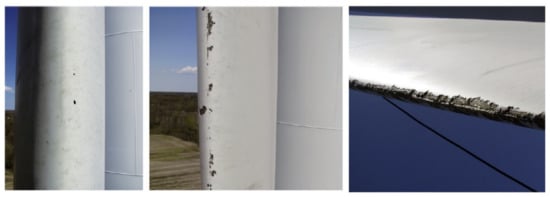
 which means that every travelling droplet hitting the tip of the blade exerts on the blade’s coating approximately a force equivalent to the weight of a 7.6 kg mass.
The force exerted will obviously vary as the wind blade rotates. Nevertheless, the above estimation serves as a good tool to estimate the magnitude of impact forces on WTBs.
In the case of hailstones, the effects on a blade’s coating can be even worse, mainly due to the expected larger diameters. The average size of hailstones is dependent on site location [43]. Measurements on-site are considered the only certain method to obtain secure estimations regarding the likely average size of hail at a specific location. In northern Greece, for example, more than 85% of the hailstones recorded between 1984 and 1993 had sizes larger than 11 mm [44], while in the United Kingdom hailstone sizes in the range of 60 mm–90 mm have been recorded [45], although these are considered freak events.
As the diameter of hailstones increases, their mass mh and kinetic energy Ekin also increase (see Equation (2)). Additionally, with increasing diameter and mass, the terminal velocity of a hailstone Vh also increases according to Equation (3), where g is the gravitational acceleration, CD is the drag coefficient (0.5 for a sphere), ρair is the air density, Ah is the cross-sectional area of the hailstone in the direction of travel and rh is the hailstone radius [46].
which means that every travelling droplet hitting the tip of the blade exerts on the blade’s coating approximately a force equivalent to the weight of a 7.6 kg mass.
The force exerted will obviously vary as the wind blade rotates. Nevertheless, the above estimation serves as a good tool to estimate the magnitude of impact forces on WTBs.
In the case of hailstones, the effects on a blade’s coating can be even worse, mainly due to the expected larger diameters. The average size of hailstones is dependent on site location [43]. Measurements on-site are considered the only certain method to obtain secure estimations regarding the likely average size of hail at a specific location. In northern Greece, for example, more than 85% of the hailstones recorded between 1984 and 1993 had sizes larger than 11 mm [44], while in the United Kingdom hailstone sizes in the range of 60 mm–90 mm have been recorded [45], although these are considered freak events.
As the diameter of hailstones increases, their mass mh and kinetic energy Ekin also increase (see Equation (2)). Additionally, with increasing diameter and mass, the terminal velocity of a hailstone Vh also increases according to Equation (3), where g is the gravitational acceleration, CD is the drag coefficient (0.5 for a sphere), ρair is the air density, Ah is the cross-sectional area of the hailstone in the direction of travel and rh is the hailstone radius [46].

4. Damages from Icing
4.1. Rime Ice
4.2. Glaze
4.3. Wet Snow
-
icing rate: ice accumulation per time (kg/h)
-
maximum ice load: maximum ice mass accreted at a structure (kg/m).
4.4. Meteorological Icing
4.5. Instrumental Icing
4.6. Incubation Time
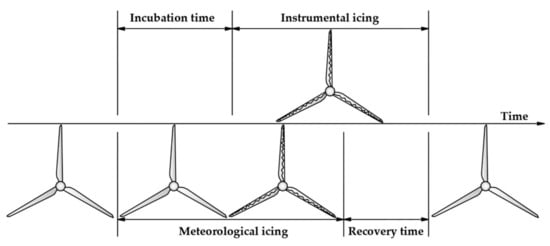
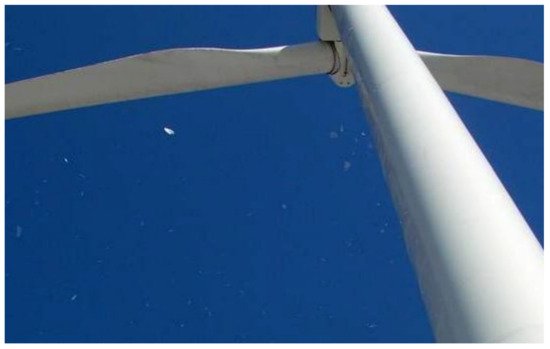
References
- Caithness Wind Farm Information Forum. Summary of Wind Turbine Accident Data to 31 March 2021. Available online: http://www.caithnesswindfarms.co.uk/AccidentStatistics.htm (accessed on 17 June 2021).
- Ideno, M.; Seki, K. Study on Improvement of Performance of wind power generation system and lightning damage. In Proceedings of the 28th International Conference on Lightning Protection, Kanazawa, Japan, 18–22 September 2006; pp. 1585–1589.
- Lightning Protection of Wind Turbines. Contract JOR3-CT95-0052. Publishable Final Report. Research Funded in Part by the European Commission in the Framework of the Non Nuclear Energy Programme JOULE III. Available online: https://cordis.europa.eu/docs/projects/files/JOR/JOR3950052/47698081-6_en.pdf (accessed on 27 July 2021).
- Kithi, R. Case Study of Lightning Damage to Wind Turbine Blade. 2008. Available online: http://www.lightningsafety.com/nlsi_lhm/wind_blade_damage.pdf (accessed on 27 July 2021).
- Wilson, N.; Myers, J.; Cummins, K.L.; Hutchinson, M.; Nag, A. Lightning attachment to wind turbines in Central Kansas: Video observations, correlation with the NLDN and in-situ peak current measurements. In Proceedings of the EWEA Annual Event, Vienna, Austria, 4–7 February 2013.
- Cummins, K.L.; Zhang, D.; Quick, M.G.; Garolera, A.C.; Myers, J. Overview of the Kansas Windfarm 2013 Field Program. In Proceedings of the International Lightning Detection Conference, Tucson, AZ, USA, 12–15 March 2014.
- Wang, D.; Takagi, N.; Watanabe, T.; Sakurano, H.; Hashimoto, M. Observed characteristics of upward leaders that are initiated from a windmill and its lighting protection tower. Geophys. Res. Lett. 2008, 35, L02803.
- Ishii, M.; Saito, M.; Natsuno, D.; Sugita, A. Lighting current observed at wind turbines at winter in Japan. In Proceedings of the International Conference on Lightning and Static Electricity, Seattle, WA, USA, 18–20 September 2013.
- Kusiak, A.; Li, W. The prediction and diagnosis of wind turbine faults. Renew. Energy 2011, 36, 16–23.
- Kong, C.; Bang, J.; Sugiyama, Y. Structural investigation of composite wind turbine blade considering various load cases and fatigue life. Energy 2005, 30, 2101–2114.
- Amirat, Y.; Benbouzid, M.E.H.; Al-Ahmar, E.; Bensaker, B.; Turri, S. A brief status on condition monitoring and fault diagnosis in wind energy conversion systems. Renew. Sustain. Energy Rev. 2009, 13, 2629–2636.
- Rodrigues, R.B.; Mendes, V.M.F.; Catalão, J.P.S. Protection of wind energy systems against the indirect effects of lightning. Renew. Energy 2011, 36, 2888–2896.
- Madsen, S.F.; Holboll, J.; Henriksen, M.; Bertelsen, K.; Erichsen, H.V. New test method for evaluating the lightning protection system on wind turbine blades. In Proceedings of the 28th International Conference on Lightning Protection, Kanazawa, Japan, 18–22 September 2006.
- Wen, X.; Qu, L.; Wang, Y.; Chen, X.; Lan, L.; Si, T.; Xu, J. Effect of Wind Turbine Blade Rotation on Triggering Lightning: An Experimental Study. Energies 2016, 9, 1029.
- Cotton, I.; Jenkins, N.; Pandiaraj, K. Lightning protection for wind turbine blades and bearings. Wind Energy 2001, 4, 23–37.
- Peesapati, V.; Cotton, I. Lightning protection of wind turbines—A comparison of real lightning strike data and finite element lightning attachment analysis. In Proceedings of the 1st International Conference of Sustainable Power Generation Supply (Supergen), Nanjing, China, 6–7 April 2009.
- Madsen, S.F.; Erichsen, H.V. Numerical model to determine lightning attachment point distributions on wind turbines according to the revised IEC 61400-24. In Proceedings of the International Conference on Lightning and Static Electricity (ICOLSE), Pittsfield, MA, USA, 15–17 September 2009.
- Naka, T.; Vasa, N.J.; Yokoyama, S.; Wada, A.; Asakawa, A.; Honda, H. Study on lightning protection methods for wind turbine blades. IEEJ Trans. Power Energy 2005, 125, 993–999.
- Yan, J.; Wang, G.; Li, Q.; Zhang, L.; Yan, J.D.; Chen, C.; Fang, Z. A Comparative Study on Damage Mechanism of Sandwich Structures with Different Core Materials under Lightning Strikes. Energies 2017, 10, 1594.
- Garolera, A.C. Lightning Protection of Flap System for Wind Turbine Blades. Ph.D. Thesis, Technical University of Denmark, Lyngby, Denmark, September 2014. Available online: http://orbit.dtu.dk/files/118015819/PhD_Thesis_Anna_Candela_Garolera.pdf (accessed on 27 July 2021).
- Garolera, A.C.; Madsen, S.F.; Nissim, M.; Myers, J.D.; Holboell, J. Lightning damage to wind turbine blades from wind farms. IEEE Trans. Power Deliv. 2016, 31, 1043–1049.
- Wind Turbines—Part 24: Lightning Protection, 1st ed.; IEC 61400-24; IEC: London, UK, 2010.
- Shohag, M.A.S.; Hammel, E.C.; Olawale, D.O.; Okoli, O.I. Damage mitigation techniques in wind turbine blades: A review. Wind Eng. 2017, 41, 185–210.
- Bulder, B.H.; Bach, P.W. A Literature Survey on the Effects of Moisture on the Mechanical Properties of Glass and Carbon Fibre Reinforced Laminates; ECN-C-91-033; U.S. Department of Energy: Washington, DC, USA, 1991.
- Reifsnider, K.F. Fatigue of Composite Materials; Elsevier: Amsterdam, The Netherlands, 1991.
- Bergeles, G. Wind Converters; Simeon Editions: Athens, Greek, 2005.
- Marín, J.C.; Barroso, A.; París, F.; Cañas, J. Study of fatigue damage in wind turbine blades. Eng. Fail. Anal. 2009, 16, 656–668.
- D’Amore, A.; Grassia, L. Principal Features of Fatigue and Residual Strength of Composite Materials Subjected to Constant Amplitude (CA) Loading. Materials 2019, 12, 2586.
- Chen, C.; Li, H.; Wang, T.; Wang, L. Influence of Structural Configurations on the Shear Fatigue Damage of the Blade Trailing-Edge Adhesive Joint. Appl. Sci. 2020, 10, 2715.
- Schramm, M.; Rahimi, H.; Stoevesandt, B.; Tangager, K. The Influence of Eroded Blades on Wind Turbine Performance Using Numerical Simulations. Energies 2017, 10, 1420.
- Hasager, C.B.; Vejen, F.; Skrzypiński, W.R.; Tilg, A.M. Rain Erosion Load and Its Effect on Leading-Edge Lifetime and Potential of Erosion-Safe Mode at Wind Turbines in the North Sea and Baltic Sea. Energies 2021, 14, 1959.
- Elert, G.; Volynets, I. Diameter of A Raindrop. 2001. Available online: http://hypertextbook.com/facts/2001/IgorVolynets.shtml (accessed on 8 March 2021).
- Villermaux, E.; Bossa, B. Single-drop fragmentation determines size of distribution of raindrops. Nat. Phys. 2009, 5, 697–702.
- Imeson, A.C.; Vis, R.; de Water, E. The measurement of water-drop impact forces with a piezo-electric transducer. CATENA 1981, 8, 83–96.
- Gaudern, N. A practical study of the aerodynamic impact of wind turbine blade leading edge erosion. J. Phys. Conf. Ser. 2014, 524, 012031.
- Slot, H.M.; Gelinck, E.R.M.; Rentrop, C.; Van Der Heide, E. Leading edge erosion of coated wind turbine blades: Review of coating life models. Renew. Energy 2015, 80, 837–848.
- Nash, J.W.K.; Zekos, I.; Stack, M.M. Mapping of Meteorological Observations over the Island of Ireland to Enhance the Understanding and Prediction of Rain Erosion in Wind Turbine Blades. Energies 2021, 14, 4555.
- Phan, P.T.S.; Huang, S.C. Analysis of material loss from brittle erosion. J. Eng. Technol. Educ. 2008, 5, 141–155.
- Balu, P.; Kong, F.; Hamid, S.; Kovacevic, R. Finite element modeling of solid particle erosion in AISI 4140 steel and nickel-tungsten carbide composite material produced by the laser-based powder deposition process. Tribol. Int. 2013, 62, 18–28.
- Aquaro, D. Erosion rate of stainless steel due to the impact of solid particles. In Proceedings of the 5th International Conference on Tribology, Parma, Italy, 20–22 September 2006.
- El Togby, M.S.; Elle, N.; Elbestawi, M.A. Finite element modelling of erosive wear International. J. Mach. Tools Manuf. 2005, 45, 1337–1346.
- Rempel, L. Rotor Blade Leading Edge Erosion—Real Life Experiences. 2012. Available online: https://www.windsystemsmag.com/wp-content/uploads/pdfs/Articles/2012_October/1012_BladeFeature.pdf (accessed on 8 April 2021).
- Nearing, M.A.; Bradford, J.M.; Holtz, R.D. Measurement of Force vs. Time Relations for Waterdrop Impact Soil. Sci. Soc. Am. J. 1986, 50, 1532–1536.
- Sioutas, M.; Meaden, G.T.; Webb, J.D.C. Hail frequency and intensity in northern Greece. In Proceeding of the 4th European Conference on Severe Storms, Trieste, Italy, 10–14 September 2007; Available online: http://indico.ictp.it/event/a06216/session/11/contribution/5/material/0/6.pdf (accessed on 8 April 2021).
- The Tornado and Storm Research Organisation (TORRO). Available online: https://www.torro.org.uk/research/hail (accessed on 8 April 2021).
- Georgia State University. Terminal Velocity. Available online: http://hyperphysics.phy-astr.gsu.edu/hbase/airfri2.html (accessed on 8 April 2021).
- Keegan, M.H.; Nash, D.; Stack, M. Numerical modelling of hailstone impact on the leading edge of a wind turbine blade. In Proceedings of the EWEA Annual Event, Vienna, Austria, 4–7 February 2013.
- Kumar, V.S.; Vasa, N.J.; Sarathi, R. Detecting salt deposition on a wind turbine blade using laser induced breakdown spectroscopy technique. Appl. Phys. A 2013, 112, 149–153.
- Cortés, E.; Sánchez, F.; O’Carroll, A.; Madramany, B.; Hardiman, M.; Young, T.M. On the Material Characterisation of Wind Turbine Blade Coatings: The Effect of Interphase Coating–Laminate Adhesion on Rain Erosion Performance. Materials 2017, 10, 1146.
- Baring-Gould, I.; Cattin, R.; Durstewitz, M.; Hulkkonen, M.; Krenn, A.; Laakso, T.; Lacroix, A.; Peltola, E.; Ronsten, G.; Tallhaug, L.; et al. Expert Group Study on Recommended Practices 13: Wind Energy Projects in Cold Climates. Available online: https://nachhaltigwirtschaften.at/resources/iea_pdf/reports/iea_windenergy_projects_in_cold_climates_2011.pdf (accessed on 10 September 2021).
- ISO 12494: 2001 Atmospheric Icing on Structures, 1st ed.; 2001-08-15. TC/SC: ISO/TC 98/SC 3. ICS: 91.080.01; ISO: Geneva, Switzerland, 2001.
- Heimo, A.; Cattin, R.; Calpini, B. Recommendations for Meteorological Measurements under Icing Conditions. In Proceedings of the 13th International Workshop on Atmospheric Icing of Structures (IWAIS), Andermatt, Switzerland, 8–11 September 2009.
- Homola, M.C.; Virk, M.S.; Nicklasson, P.J.; Sundsbø, P.A. Performance losses due to ice accretion for a 5MW wind turbine. Wind Energy 2012, 15, 379–389.
- Barber, S.; Wang, Y.; Chokani, N.; Abhari, R.S. The Effect of Ice Shapes on Wind Turbine Performance. In Proceedings of the 13th International Workshop on Atmospheric Icing of Structures (IWAIS), Andermatt, Switzerland, 8–11 September 2009.
- Gantasala, S.; Tabatabaei, N.; Cervantes, M.; Aidanpää, J.O. Numerical Investigation of the Aeroelastic Behavior of a Wind Turbine with Iced Blades. Energies 2019, 12, 2422.
- Gantasala, S.; Luneno, J.C.; Aidanpää, J.O. Influence of Icing on the Modal Behavior of Wind Turbine Blades. Energies 2016, 9, 862.
- Tesauro, A.; Pavese, C.; Branner, K. Rotor Blade Online Monitoring and Fault Diagnosis Technology Research; Technical Report No. 0042; Department of Wind Energy, Denmark Technical University: Lyngby, Denmark, 2014.
- Davis, N. Icing Impacts on Wind Energy Production. 2014. Available online: https://backend.orbit.dtu.dk/ws/portalfiles/portal/104279722/Icing_Impacts_on_Wind_Energy_Production_final.pdf (accessed on 11 September 2021).

